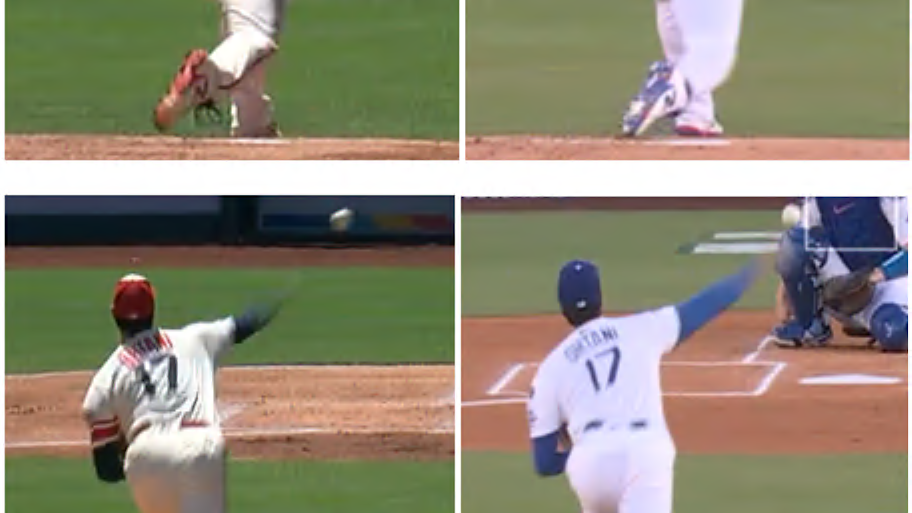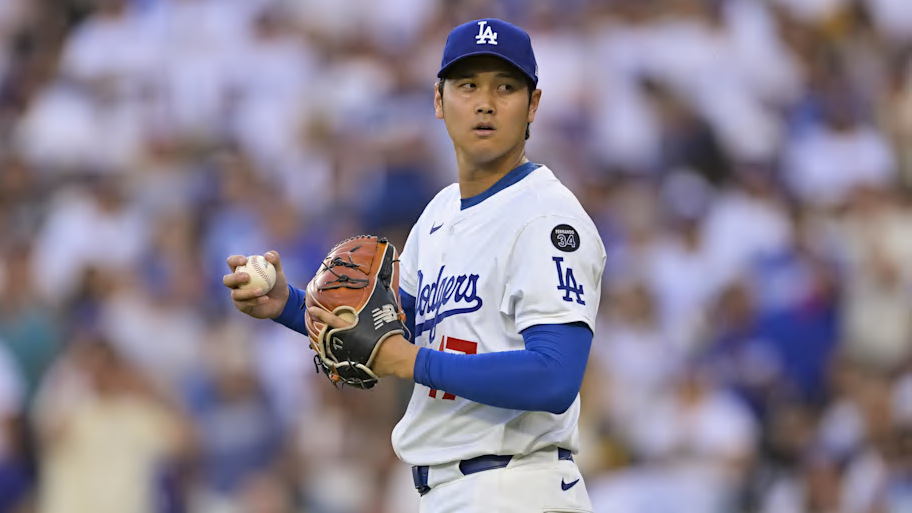Shohei Ohtani essentially threw a rehab start at Dodger Stadium against the San Diego Padres Monday. Too valuable as a hitter to the Los Angeles Dodgers to send to a normal minor league rehab stint to build arm strength, Ohtani returned immediately to a big league mound for the first time in 662 days and after undergoing a second elbow procedure.
How did he look? Amazing, of course. Only Ohtani could throw a pitch 100.2 mph and hit a double 105.2 mph after not pitching for 22 months.
It’s only one start—the equivalent of a rehab outing, at that—so we’re a long way from drawing any conclusions. But it’s our first look at Ohtani pitching for the Dodgers, so let’s dive into first impressions. Here’s what we learned from Ohtani’s debut as a Dodgers pitcher:
Ohtani is throwing harder than ever.
His average four-seam fastball velocity of 99.1 mph was a career high in his 84 games. Wait, you say, he only threw one inning; of course, it was higher.
Ok, then: it was the highest first-inning velo in his career, topping the 98.9 mph he averaged just before he was hurt in August 2023.
Ohtani threw from the windup.
We had not seen that before. I like it, especially for a guy with two elbow procedures. He is tall and athletic, assets that should not be diminished by pitching from the abbreviated stretch with bases empty.
Ohtani threw from the lowest release point of his career.
His release point was 2 1/4 inches lower than where it was in 2023. This continues a trend for him. His release point Monday was 6 3/4 inches lower than in 2021.
Here you can see how his release point over the years has gradually declined (all pitches here are four-seam fastballs with the bases empty):

Ohtani is driving down the mound differently.
Ohtani previously left the rubber with nearly a “jump” to his front side. His movement was more controlled Monday. You can see this in the position of his plant foot.
In 2023, his plant foot comes off the rubber earlier and gets higher off the ground as he transitions to his front side. On Monday, there was more of a drag with his plant foot leaving the rubber and less “jump” to his stride. It adds up to slightly less extension at ball release.

Ohtani broke out a new toy.
He officially joined the Three S Revolution: Shaping, Sequencing & Spin. Ohtani started throwing a two-seamer in 2022. He threw it only 3.7% that year and 5.7% the next. On Monday he threw 28.6% sinkers, including three front-door sinkers to left-handed hitters.
Those three comeback sinkers to lefties—Greg Maddux specials—were more than he had thrown in any game of his career, and he did it in just one inning. It’s a signal that Ohtani, like Paul Skenes, who has made a similar addition, understands that shaping and sequencing pitches are more important these days than just individual pitch metrics.
His secondary stuff isn’t there yet.
Ohtani threw only one splitter, and it was too firm (91.3). His sweeper, also firmer, had almost three inches less horizontal break. It’s not surprising. The touch on off-speed and spin will come with more reps.
Ohtani lacked the ability to finish hitters.
He threw 12 pitches with two strikes and never got strike three. The Padres went 2-for-3 (.667) against Ohtani in two-strike counts, the highest average against him in any game with more than one at-bat decided on a two-strike count.
How unusual is it for Ohtani not to finish hitters when he gets them to two strikes?
Lowest Batting Average Allowed With Two Strikes
*(Min. 85 starts since 1988)
The Unicorn did it again.
He keeps finding ways to amaze us, usually in manners most people have never seen. Monday night he became the first National League player since Alvin Dark in 1953 to start the game as a pitcher and leadoff batter. But that precedent doesn’t really apply.
Dark was a middle infielder and New York Giants team captain who was one of manager Leo Durocher’s favorites. It was the last game of the year for a losing Giants team that had long been eliminated, so Dark’s one inning on the mound was a lark.
Removing that instance, the last time an NL pitcher batted leadoff was Jim Jones of the Giants on Sept. 30, 1901, in the second game of a doubleheader. That also was more comic than serious. Jones was a right fielder who had pitched once in his career, a relief outing of 6 2/3 innings for the Louisville Colonels in 1897 in which he gave up … get this, 22 runs.
The 1901 Giants (52–82 at the time) were a bad team playing out the last days of the season and playing a second straight doubleheader against the Cardinals. Giants manager George Davis decided to start Jones, his right fielder, in the last of those four games in two days, a game by mutual agreement of the clubs would be cut to six innings. Only 2,500 people were at Robison Field in St. Louis to watch that second game of a doubleheader in which, as the New York Times put it, “both teams played gruesome baseball.”
The Cardinals won, 6–5. Jones pitched a complete game, lowering his career ERA to 15.43. He never pitched again.
Watching Ohtani is like nothing else, especially with what he had to do between the top and bottom of the first inning. Ohtani had just thrown 28 pitches in the top of the first. Walking off the mound, he stopped for the routine sticky-substance check from the umpire. As the leadoff hitter, he did not have time to get a drink or even go into the dugout. A bat boy met him on the warning track in front of the Dodger dugout with his hitting accoutrements: bat, helmet, batting gloves, arm guard and shin guard. With the between-innings clock counting down, he changed into his hitting gear and stepped in to hit against Dylan Cease. Ohtani saw seven pitches—which means he personally accounted for the first 35 pitches of the game—and struck out.
He later added two hits, raising his batting average to .300. The starting pitcher for the Dodgers that night leads the league in home runs (25) and slugging (.643).
That sentence deserves to be re-read.
But it was the simple, Little League-like tableau in the middle of the first inning that was most amazing of all. Walking off the mound and grabbing a bat to lead off, with no time for water or an orange slice, Ohtani once again played baseball like a 10-year-old on a small community diamond and, at the same time, like no other major leaguer we’ve seen.
More MLB on Sports Illustrated
This article was originally published on www.si.com as Shohei Ohtani Returns to Mound As Unique As Ever With Room to Improve.
